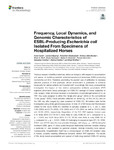2021-04-16Zeitschriftenartikel
Frequency, Local Dynamics, and Genomic Characteristics of ESBL-Producing Escherichia coli Isolated From Specimens of Hospitalized Horses
Kauter, Anne
Epping, Lennard
Ghazisaeed, Fereshteh
Lübke-Becker, Antina
Wolf, Silver A.
Kannapin, Dania
Stoeckle, Sabita D.
Semmler, Torsten
Günther, Sebastian
Gehlen, Heidrun
Walther, Birgit
Previous research identified veterinary clinics as hotspots with respect to accumulation and spread of multidrug resistant extended-spectrum β-lactamase (ESBL)-producing Escherichia coli (EC). Therefore, promoting the prudent use of antibiotics to decrease selective pressure in that particular clinical environment is preferable to enhance biosecurity for animal patients and hospital staff. Accordingly, this study comparatively investigated the impact of two distinct perioperative antibiotic prophylaxis (PAP) regimens (short-term versus prolonged) on ESBL-EC carriage of horses subjected to colic surgery. While all horses received a combination of penicillin/gentamicin (P/G) as PAP, they were assigned to either the “single-shot group” (SSG) or the conventional “5-day group” (5DG). Fecal samples collected on arrival (t0), on the 3rd (t1) and on the 10th day after surgery (t2) were screened for ESBL-EC. All isolates were further investigated using whole genome sequences. In total, 81 of 98 horses met the inclusion criteria for this study. ESBL-EC identified in samples available at t0, t1 and t2 were 4.8% (SSG) and 9.7% (5DG), 37% (SSG) and 47.2% (5DG) as well as 55.6% (SSG) and 56.8% (5DG), respectively. Regardless of the P/G PAP regimen, horses were 9.12 times (95% CI 2.79–29.7) more likely to carry ESBL-EC at t1 compared to t0 (p < 0.001) and 15.64 times (95% CI 4.57–53.55) more likely to carry ESBL-EC at t2 compared to t0 (p < 0.001). ESBL-EC belonging to sequence type (ST) 10, ST86, ST641, and ST410 were the most prevalent lineages, with blaCTX–M–1 (60%) being the dominant ESBL gene. A close spatio-temporal relationship between isolates sharing a particular ST was revealed by genome analysis, strongly indicating local spread. Consequently, hospitalization itself has a strong impact on ESBL-EC isolation rates in horses, possibly masking differences between distinct PAP regimens. The results of this study reveal accumulation and spread of multi-drug resistant ESBL-EC among horses subjected to colic surgery with different P/G PAP regimens, challenging the local hygiene management system and work-place safety of veterinary staff. Moreover, the predominance of particular ESBL-EC lineages in clinics providing health care for horses needs further investigation.
Dateien zu dieser Publikation

